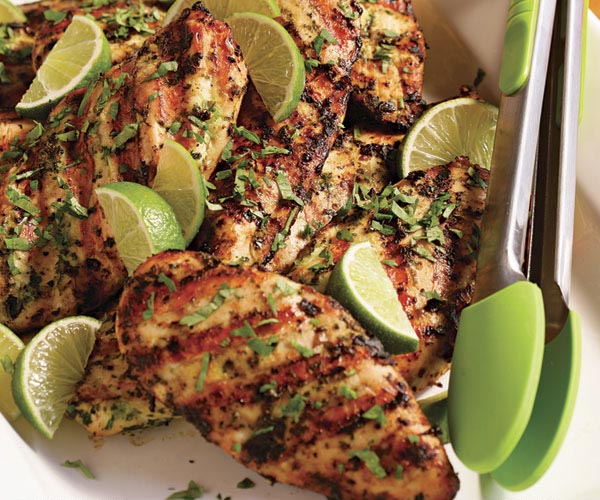Grilled Thai Chicken Breasts with Herb-Lemongrass Crust

Though these breasts are great served hot off the grill, they’re also fine served cold in the coming days, either plain or sliced atop a salad.
Prep Time:
Cook Time:
Total Time:
Ingredients:
| 1 1/2 cups | chopped fresh cilantro (leaves and tender stems) |
| 3/4 cup | coconut milk |
| 1/4 cup | finely chopped lemongrass (from about 2 stalks) (see note below) |
| 12 | fresh basil leaves |
| 3 | thai bird chiles, 2 jalapeños, or 2 medium serranos, stemmed, seeded, and finely chopped |
| 3 cloves | garlic, minced |
| 1 1/2 tablespoons | kosher salt |
| 2 teaspoons | packed light brown sugar |
| 1 1/2 teaspoons | freshly ground black pepper |
| 3/4 teaspoon | ground coriander |
| 12 | boneless, skinless chicken breasts halves (5 to 5-1/2 lb.), trimmed (remove the tenderloins if still attached) |
| 2 | limes, cut into wedges for serving |
Directions:
Combine 1-1/4 cups of the cilantro with the coconut milk, lemongrass, basil, chiles, garlic, salt, brown sugar, pepper, and coriander in a food processor or blender and purée until smooth. Arrange the chicken breasts in a nonreactive baking dish or other vessel large enough to accommodate them in a snug single layer. Pour the marinade over the breasts and turn to coat them well. Cover and refrigerate for at least 2 hours and up to 1 day.
Heat a gas grill to medium high or prepare a medium-hot charcoal fire. Grill the chicken (covered on a gas grill) until it has good grill marks on the first side, 4 to 5 minutes. Flip the chicken (cover a gas grill) and continue to cook until firm to the touch and completely cooked through (check by making a slice into one of the thicker breasts), 5 to 6 more minutes. Transfer to a platter and let rest for 5 minutes. Sprinkle with the remaining 1/4 cup cilantro and serve with the lime wedges.
Note: Before chopping the lemongrass, be sure to cut off the spiky green top and enough of the bottom to eliminate the woody core. Peel off a few of the outer layers until you’re left with just the tender heart of the stalk.
Source: finecooking.com
